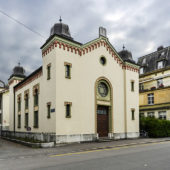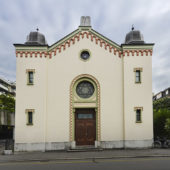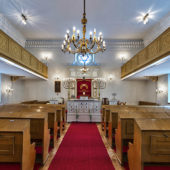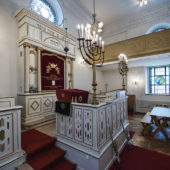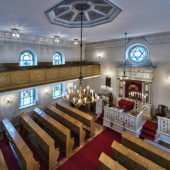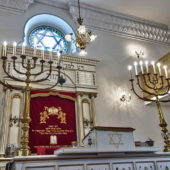Located in the city where famous Rolex is headquartered, this building has all the precision of a fine Swiss watch
The Jewish Community and its Synagogue in Biel (recent age)
By Haim Madjar of Biel
The formation of a Jewish community in the city Biel came only after the mid-19th Century. In 1819 a Jewish name was recorded for the first time in the city. In the 1833 census, Jews were not counted in the city. In 1837 several Jewish people / families have moved from Alsace.
Since 1839 down settling in the city was basically again possible. 1844 Biel City Government decided to lower the taxes for voluntary immigration of watchmakers what enabled some others Jewish watchmakers to move with their families from Lyon and Dresden to Biel.
Since 1846 due to the Bernese Constitution, all Swiss citizens regardless of their faith were legally equal, which further promoted the immigration of Jewish families to Biel.
In 1848 the Jews of the city decided to pray together every Sabbath. First they met in the homes of individual families. Ten years later, on 27 October 1858, the establishment of a \\\”Praying room\\\” was approved by letter of the Government Council addressed to Government governor in Biel. Thus the formation of the Jewish Community was established.
In August 1858, 52 Jewish people lived already in Biel. Within the next 30 years, the Jewish community grew to over 200 people.
During the 1870s due to the growth of the local community, there were increasing efforts to build a synagogue. In July 1882 suitable land could be found at the Ruschli Street. The plans for the new synagogue were drawn by the architect Johann Jakob Frey and August Eduard Hague. They proposed the architecture of the synagogue, the widespread neo-Oriental \\\”Moorish\\\” style.
By the end of the year 1882 the community began selling the praying seats in the new synagogue. The prices were between 400 and 1,400 francs, which was a considerable sum at that time.
The official inauguration of the synagogue took place on 7 September 1883. The Synagogue service was held by the Chief Rabbi Joseph Wertheimer from Geneva.
In the following decades, the synagogue was renovated again and again, especially in 1923; new painting of the interior of the synagogue, the candlestick electrification and new windows glazing.
In 1995 again a major renovation took place. New windows designed by the Israeli artist Robert Nechin were installed. An intervention in the formative neo – oriental architecture of the synagogue was again reversed. The four domes of the corner towers, which were changed in 1974, have been restored again.
November 6, 2013

